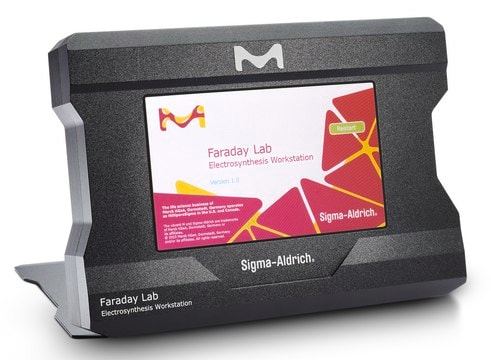There is no documentation on the elemental and/or structural analysis of the electrode, including the percentages of amorphous carbon versus graphite. This product is made from glassy carbon, which is a non-graphitizing carbon material.
ESYNTH019
SynLectro™ Glassy Carbon Electrode
size 3 mm × 20 mm × 60 mm
Synonym(s):
Glassy Carbon SynLectro™ Electrode
About This Item
Recommended Products
size
3 mm × 20 mm × 60 mm
Related Categories
General description
SynLectro™ Electrolysis Platform
The SynLectro™ Electrolysis Platform is a portfolio of labware products and electrodes designed to simplify and standardize preparative scale electrosynthesis. Learn more about each component, designed with consistency, reproducibility, and safety in mind.
Legal Information
Choose from one of the most recent versions:
Certificates of Analysis (COA)
It looks like we've run into a problem, but you can still download Certificates of Analysis from our Documents section.
If you need assistance, please contact Customer Support.
Already Own This Product?
Find documentation for the products that you have recently purchased in the Document Library.
Related Content
Learn about our new SynLectro™ Electrolysis Platform that has been designed to simplify and standardize electrochemical organic synthesis at research and batch scale.
Learn about our new SynLectro™ Electrolysis Platform that has been designed to simplify and standardize electrochemical organic synthesis at research and batch scale.
Learn about our new SynLectro™ Electrolysis Platform that has been designed to simplify and standardize electrochemical organic synthesis at research and batch scale.
Learn about our new SynLectro™ Electrolysis Platform that has been designed to simplify and standardize electrochemical organic synthesis at research and batch scale.
-
Is there any kind of documentation on the elemental and/or structural analysis of the electrode? I.e. what percentage is amorphous carbon vs graphite?
1 answer-
Helpful?
-
-
Is it possible to cut the electrode ESYNTH019-1EA into smaller pieces, for example, cutting it in half to make 3mm x 10mm x 30mm from the original 3 mm × 20 mm × 60 mm? If so, what is the best method for doing so - diamond scribe or some other method?
1 answer-
In the past, diamond scribers have been used for this purpose. However, this method requires quickly pressing an edge against it on the reverse side. If the customer has access to a mechanical workshop, a diamond saw is recommended. It should be noted that glassy carbon becomes harder with higher pressure. Therefore, when using a diamond saw, it is advisable to saw slowly and not apply excessive pressure.
Helpful?
-
Active Filters
Our team of scientists has experience in all areas of research including Life Science, Material Science, Chemical Synthesis, Chromatography, Analytical and many others.
Contact Technical Service








